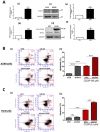Orai3-Mediates Cisplatin-Resistance in Non-Small Cell Lung Cancer Cells by Enriching Cancer Stem Cell Population through PI3K/AKT Pathway
- PMID: 34065942
- PMCID: PMC8150283
- DOI: 10.3390/cancers13102314
Orai3-Mediates Cisplatin-Resistance in Non-Small Cell Lung Cancer Cells by Enriching Cancer Stem Cell Population through PI3K/AKT Pathway
Abstract
The development of the resistance to platinum salts is a major obstacle in the treatment of non-small cell lung cancer (NSCLC). Among the reasons underlying this resistance is the enrichment of cancer stem cells (CSCs) populations. Several studies have reported the involvement of calcium channels in chemoresistance. The Orai3 channel is overexpressed and constitutes a predictive marker of metastasis in NSCLC tumors. Here, we investigated its role in CSCs populations induced by Cisplatin (CDDP) in two NSCLC cell lines. We found that CDDP treatment increased Orai3 expression, but not Orai1 or STIM1 expression, as well as an enhancement of CSCs markers. Moreover, Orai3 silencing or the reduction of extracellular calcium concentration sensitized the cells to CDDP and led to a reduction in the expression of Nanog and SOX-2. Orai3 contributed to SOCE (Store-operated Calcium entry) in both CDDP-treated and CD133+ subpopulation cells that overexpress Nanog and SOX-2. Interestingly, the ectopic overexpression of Orai3, in the two NSCLC cell lines, lead to an increase of SOCE and expression of CSCs markers. Furthermore, CD133+ cells were unable to overexpress neither Nanog nor SOX-2 when incubated with PI3K inhibitor. Finally, Orai3 silencing reduced Akt phosphorylation. Our work reveals a link between Orai3, CSCs and resistance to CDDP in NSCLC cells.
Keywords: Cisplatin; Orai3; cancer stem cell markers; chemoresistance; non-small cell lung carcinoma; store-operated calcium entry.
Conflict of interest statement
The authors declare no conflict of interest.
Figures










References
-
- Noone A.-M., Cronin K.A., Altekruse S.F., Howlader N., Lewis D.R., Petkov V.I., Penberthy L. Cancer Incidence and Survival Trends by Subtype Using Data from the Surveillance Epidemiology and End Results Program, 1992–2013. Cancer Epidemiol. Biomark. Prev. 2017;26:632–641. doi: 10.1158/1055-9965.EPI-16-0520. - DOI - PMC - PubMed
-
- Hanna N., Johnson D., Temin S., Baker S., Brahmer J., Ellis P.M., Giaccone G., Hesketh P.J., Jaiyesimi I., Leighl N.B., et al. Systemic Therapy for Stage IV Non-Small-Cell Lung Cancer: American Society of Clinical Oncology Clinical Practice Guideline Update. J. Clin. Oncol. Off. J. Am. Soc. Clin. Oncol. 2017;35:3484–3515. doi: 10.1200/JCO.2017.74.6065. - DOI - PubMed
LinkOut - more resources
Full Text Sources
Research Materials
Miscellaneous

